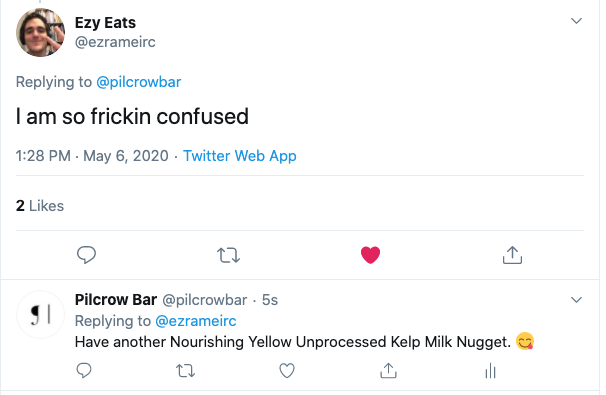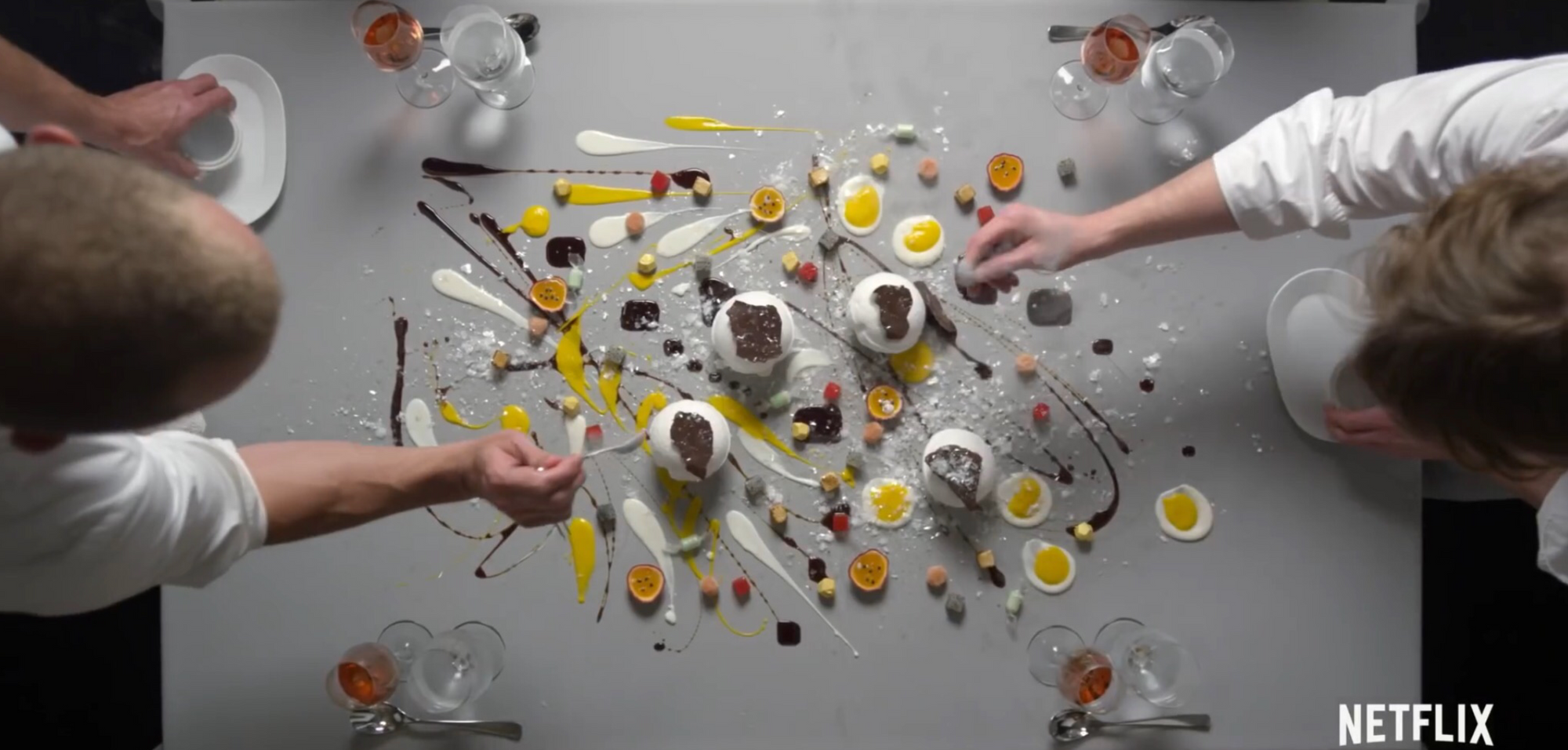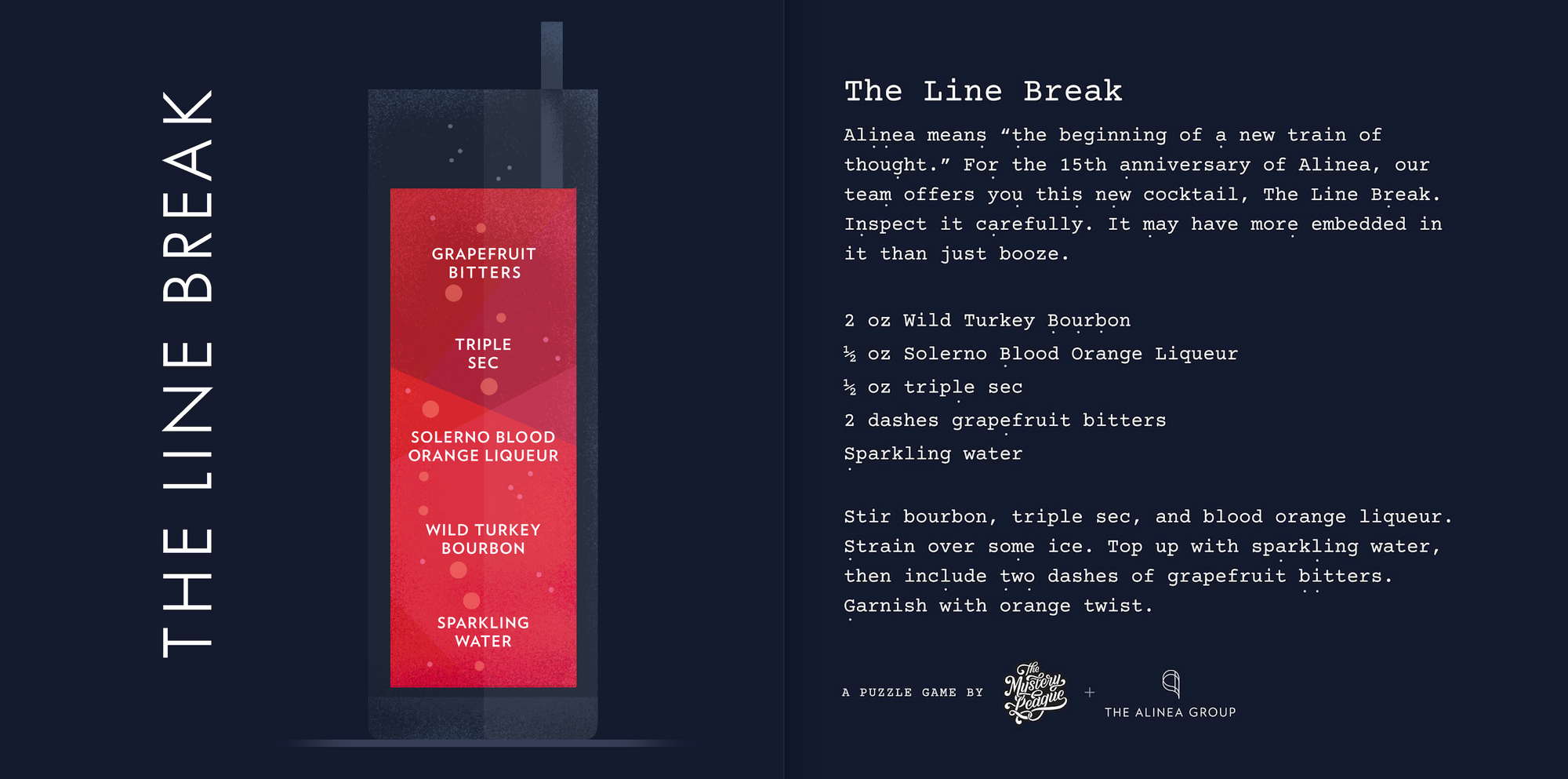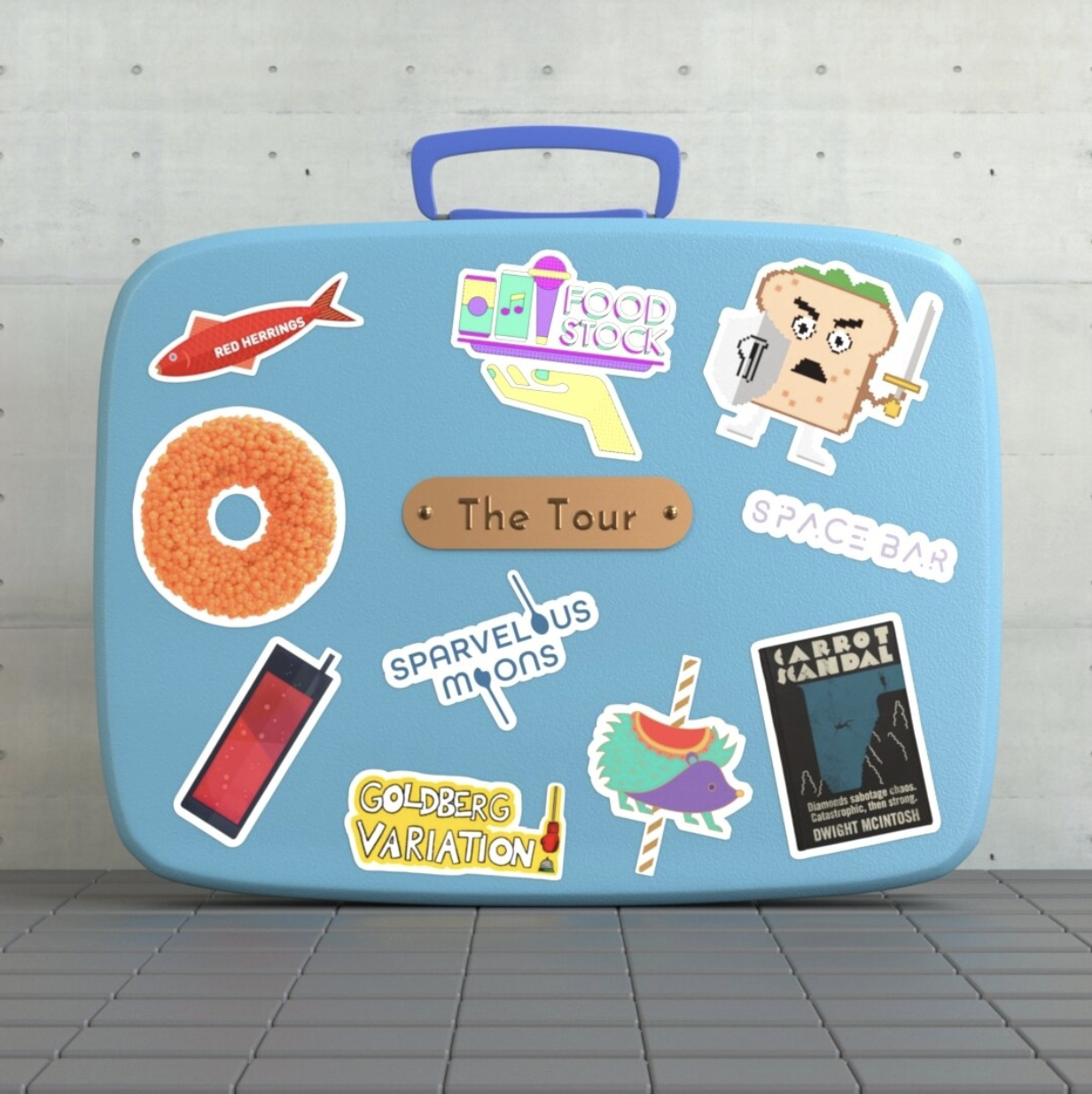Pilcrow Bar: A Pandemic Puzzle Project
A retrospective on Pilcrow Bar, the 10,000-person puzzle hunt made by Sandor Weisz and Matthew Stein for Alinea.
By Matthew Stein and Sandor Weisz
Throughout the spring of 2020, over 10,000 players dug into Pilcrow Bar, a series of intricate food-themed puzzles created in celebration of the 15th anniversary of Alinea, a Michelin 3-star restaurant in Chicago.
Pilcrow Bar was part of a long tradition of games known as puzzle hunts. In a puzzle hunt, teams of players tackle a series of puzzles that are intricate enough to require communication, collaboration, and extended concentration, yet elegant enough to inspire players to push through to the final “aha.” These range from the complex annual MIT Mystery Hunt to monthly, novice-friendly Puzzled Pint. The massive engagement we saw through Pilcrow Bar, which included thousands of people who had never participated in anything like this before, was proof that there are tens of thousands of people out there who would really enjoy and benefit from puzzle hunts — but just haven’t been exposed to them yet.
As the puzzle designers behind Pilcrow Bar, we’d like to tell the story of how the game played out, show how some of our favorite puzzles worked, and share some useful lessons we learned along the way from the whole experience. We’ll avoid major spoilers for most of the puzzles as we hope that after reading this article, you might be interested in visiting pilcrow.bar to give them a try yourself!

Beginnings
In April 2020, the world was reeling with tragedy and uncertainty as everyone began to recognize the full magnitude of the COVID-19 pandemic. The floor had just fallen out from our businesses, which relied on in-person events, and we were scrambling to come up with ways to pivot to the new normal of remote work and Zoom events. Sandy put out a note in his newsletter asking for ideas, and he got an intriguing response from his friend Nick Kokonas, co-owner of Alinea.
Nick wanted a public puzzle game to celebrate the 15th anniversary of Alinea, an event that would occur while the restaurant was shuttered due to the pandemic. Nick’s original idea was a puzzle embedded in the menu that diners would take home when they picked up an order from the restaurant’s new prepared meal service.
Worried diners might throw the puzzle away without even noticing it was there, and excited to think big, we pitched something much more expansive: a puzzle hunt, made up of 10 puzzles and a metapuzzle, with a new puzzle released online every few days.
Puzzle hunt puzzles can take many forms — ranging from familiar formats (like word and logic puzzles) to things that don’t immediately seem like puzzles at all (such as a restaurant menu, a deck of cards, a musical playlist, or a collection of cat pictures) to puzzles that look like one thing but are actually something completely different. A unifying feature is that these puzzles don’t come with instructions: the first step is always figuring out what to do. To help with this, the puzzles are prefaced with a few lines of flavor text that gives the solver some hints, directly or obliquely, on how to crack it open.
Each puzzle also has an expected output: using some unknown mechanic, the solver will be able to extract a single word or phrase as a final answer. Puzzles typically require multiple steps and, given the infinite depth of the Internet, may require referencing external sources of information.
Puzzle hunts also typically have a meta-structure, where the answers from individual puzzles in a round are combined to solve a culminating metapuzzle. Larger puzzle hunts may even have meta-metapuzzles — puzzles that use the answers from the metapuzzles from multiple rounds.
We knew that coming up with the right theme was our first step. As we began discussing theme ideas, we witnessed a cascade of escape room companies attempting to quickly pivot to digital alternatives. In addition to these shifts in medium, the industry also experienced a shift in tonal preference; games with darker themes suddenly felt way too close to home. We’ve long held the belief that “escape” rooms are actually “escapist” rooms. That is, they are less defined by the potential objective of escaping a physical room and more about escaping to an alternate reality. With this in mind, we attempted to find the right escapist tone for this game.

Alinea itself emerged as the most obvious source of inspiration, and it quickly became apparent that there are strong parallels between Alinea’s philosophy around culinary experiences and ours around puzzle experiences. In his Chef’s Table episode, Alinea’s Chef Grant Achatz describes how guests at Alinea should “expect the unexpected” as they’re presented with dishes that defy and subvert expectations. This dining experience is sensory, cerebral, and full of surprises. “Until you lift that lid and peer inside, you don’t know what’s really in there. And then there’s the reveal. And then there’s the reward. It’s a magic show,” Chef Grant says in the episode. This reveal is a shift in perception when “the guest has the ‘aha’ moment where they feel that they’ve discovered something.” We were struck by how close this is to the language we use when designing puzzles. He even describes the concept behind one particular menu like a final metapuzzle: “Let’s say we take one component from all the courses that we then use to make the final dessert. All the flavors that you just experienced in the meal would be represented in the final course.”
Alinea itself is already in the business of the hyper-real; we decided we needed to take this game to the realm of the absurd. We soon landed on the concept of pop-up restaurants, which we liked because each pop-up could be based around a unique concept, and each pop-up could require a secret password for “entrance,” providing a diegetic reason for each puzzle to produce an answer phrase . While Alinea is still bound by the earthly constraints that their food be delicious and physically possible, each of our pop-ups could be a complete thought experiment, with the concept of food serving the form and function of underlying puzzle layers. We looked to real pop-up restaurants we have been to or heard about — where eye-catching marketing and menus are often presented only in a liminal digital form — and to the efforts of historic and contemporary speakeasies.
We also had a secret ingredient for this project: we got to collaborate with Allen and Sarah Hemberger, the incredible artists behind the books The Alinea Project, The Aviary Cocktail Book, and Zero. Not only are these two artistic wizards intimately familiar with Alinea’s brand, but Allen previously was an animator at Weta and Pixar and could render any bonkers thing we came up with, and Sarah is an all-star illustrator with a range of styles who managed to pick the right aesthetic for every brand we made up.
The Bar Is Open
Puzzlers love their puns, and puzzle hunt designers often let the tail wag the dog; that is, we come up with the final pun first and build the whole hunt around it. “Alinea” is a name for the ¶ symbol, aka the “pilcrow”, indicating a new paragraph, and it metaphorically represents “the beginning of a new train of thought.” As we started discussing this project, we began riffing on “pilcrow” puns -- our early favorite was “Pilcrow Magnon,” but we settled on an excellent restaurant-related variant as the launching point for our game: Pilcrow Bar.
Much like a diner’s experience at Alinea, we envisioned this puzzle hunt to embody a meal-like structure. We’d start with a cocktail at the bar (an onboarding warmup puzzle), transition into a few appetizers (beginner-friendly puzzles), move onto a multi-course entrée (more substantive, multi-layered puzzles), and end with dessert (a metapuzzle tying together all the motifs of the game.)
The intro puzzle of the game — the “cocktail at the bar” — was quite literally cocktail-themed: a cocktail recipe that also contained a small visual puzzle in the recipe itself. Matthew is an avid mixologist and over the past few years has been hosting “Cryptic Cocktails” soirées at which he presents a collaboratively written puzzle hunt along with per-puzzle cocktail pairings. Inspired by this, he created a refreshing summery cocktail, aptly named “The Line Break,” which had ingredients satisfying the specific constraints of the puzzle. This recipe had the unique property of solving to an answer and actually tasting good.

To solve this puzzle, you need to read the letters marked with a small dot on the written instructions to get the instruction INSTAGRAM USERNAME BUBBLES SMALL TO BIG. Then, on the cocktail illustration, note that there is exactly one large and one medium bubble surrounding each ingredient name. (Ignore the really tiny bubbles.) Connect these pairs in the small-to-big direction to get 5 bigrams: PI LC RO WB AR. Recalling from the initial instruction that this is an Instagram username, follow @pilcrowbar to continue the hunt.
The morning The Line Break launched, we were overwhelmed by an almost instantaneous response. The @pilcrowbar account skyrocketed to nearly 10k followers overnight. We received hundreds of comments over social media and email excitedly sharing solvers’ experiences with the first puzzle and anticipation of whatever was to come. A few solvers with well-stocked home bars even sent us photos of The Line Break cocktails they’d made.
We also encountered some stressful hiccups on day one. The intermediate phrase (originally reading INSTAGRAM USERNAME BUBBLES SMALL 2 BIG) was meant to clue the next step of the puzzle, leading players to our Instagram account. This had worked smoothly as intended in all our playtests of the puzzle. However, quite a few players, especially those unfamiliar with this style of multi-step puzzle design, interpreted this phrase more literally and tried to visit @bubblessmall2big. By the time we realized this unintentional rabbit hole, an intrepid business had already registered this handle, posted something self-promotional, and gained thousands of followers within hours. We quickly pivoted and registered @bubblessmalltobig, and updated the puzzle to direct there, which did the trick for new visitors. Lesson learned: small errors can have big consequences when working at scale.
A Multi-Course Meal
When we launched the cocktail puzzle, we knew the full game would be nine puzzles long, plus a metapuzzle at the end. At that point, however, we only had one puzzle finished and one in the works. It might have been smarter to plan out this whole endeavor months earlier, but we didn’t have that luxury of time. Instead, we had to lay the track as we went. We typically built each puzzle, from conception to launch, within the span of one week. It was stressful! But it was also intensely exhilarating to go from zero to launch that quickly.
SPOILER WARNING! The next section references mechanics and solutions to some of the puzzles in Pilcrow Bar. However, this article is not at all intended to be a full walkthrough of the solutions. In fact, we hope this article inspires you to go try these puzzles on your own if you haven’t already! (But if you do just want to know how all the puzzles work, you can find detailed solution writeups under the “Hints & Solutions” tab on the Pilcrow Bar website.)
Beyond the intro cocktail puzzle, Pilcrow Bar took solvers to visit 9 puzzle pop-up restaurants, each with a distinctive concept:
- Space Bar: A futuristic laboratory of astronomic gastronomy.
- Foodstock: A pun-tastic ode to the mashing up of food and music.
- Torus: Savory tastes, all in a sweet donut shape.
- The Gallop Pole: On this carousel, each dish is based on the personality of the animal you’re riding.
- Sparvelous Moons: 25 flavors of edible spoons.
- Sandwich Castle: A 10-level PuzzleScript game that concealed a moderately complex word puzzle.
- Word Salad: Three chapters, each with 100 words of what seems like pure gibberish.
- Goldberg Variation: Cross your fingers that our overengineered Rube Goldberg contraption gets your food to the table safely and in one piece.
- Red Herrings: Where we serve literal red herrings as the main course, of course.
In many of these puzzles, the title or theme also hinted at the core puzzle mechanics. For instance, Space Bar utilized the layout of a QWERTY keyboard. Torus was based both around zodiac signs (a la Taurus) and the torus-shaped letter “O.” Sparvelous Moons, a spoonerism of “Marvelous Spoons,” suggested the cluing of various spoonerized phrases.
We designed and released the puzzles generally in order of increasing difficulty and complexity. Puzzles earlier in the hunt introduced core puzzle hunt mechanics and conventions — including indexing, ordering, and intermediate instruction phrases — which reappeared in later puzzles in increasingly more intricate, multilayered ways. This progression allowed participants, many of whom hadn’t previously been exposed to puzzle hunts, to incrementally “level up” their puzzle-solving skills and, by the end, succeed in solving genuinely insidious puzzles which they would have been loathe to tackle at the start of the game.
Heavy Meta

Puzzle hunt design is usually done backwards: you almost always design the metapuzzle first, as it determines the constraints on the answers for all preceding puzzles. In Pilcrow Bar, our architectural development might be better described as “middle out.” Though we brainstormed a bunch of meta ideas upfront, we hadn’t fully settled on one by the time we released the first few puzzles.
We can’t overstate how risky of an approach this is. Ten out of ten puzzle constructors would not recommend it.
But we also know the best puzzle ideas are often found, not forced. We noticed that the first couple of feeder answers we’d chosen were 10 letters long, which provided an accidental structure for us. Given that we had 10 puzzles planned, we knew that if we stick to 10-letter answers, the set of them would get us a lovely 10x10 grid. Furthermore, we could also have our ten-letter title PILCROWBAR serve as an acrostic down the left column, giving players a way to order their answers.
We also chose a punny meta answer we really liked… which just happened to be 26 letters long, setting us up to reprise an A-Z ordering mechanic introduced in a previous puzzle. We just needed to ensure that our feeder puzzle answers would have all the letters we’d need for the meta answer. That was no small feat, given we had just 100 letters to play with, but it wasn’t impossible. As long as we could lock that in, we could punt on the actual meta construction until later (which was fortunate, as we hardly had time for it at the start.)
Weeks later, as we began to near the end of the hunt, we knew we had to finally return to the metapuzzle. We wanted it to be both whimsical and nostalgic in tone, to be more fun than hair-pulling, and to represent a satisfyingly climactic conclusion to Pilcrow Bar’s two-month arc. Our first concept for the puzzle involved a visual presentation inspired by Alinea’s iconic tabletop dessert plating, but we couldn’t figure out a way to produce the visuals for it without heading to the restaurant and staging actual food, which was sadly out of the question. The Sandwich Castle puzzle had inspired us to try more interactive experiences, so we landed on the idea of a text adventure.
In our text adventure, players traversed a 100-room labyrinthian mega-pop-up. Most rooms were empty, but 26 rooms contained servers and various peculiar sights. These rooms turned out to be a collection of escape room-esque mini-puzzles which each referenced the core mechanic of one of the original 10 feeder puzzles and yielded a single letter. Sorting these letters in A-Z order and pulling out letters in the corresponding positions from the 10x10 grid of previous puzzle answers led to the final answer of the game — the 26-letter phrase WISHING YOU MANY HAPPY RETURNS, one final punny allusion to the ¶ symbol.
Reflections
Now one year past Pilcrow Bar, it still stands out as one of the most impactful, zany, and boundary-pushing projects we’ve had the chance to work on. Looking back, we’ve learned a few valuable lessons from this whole thing.
Puzzle solving fosters collaboration and community. We savored stories from players about how Pilcrow Bar helped them stay close to family, friends, and partners from afar, get through the sickness or death of loved ones, balance out job difficulties, and make friends with strangers through ad hoc communities on Instagram or Reddit. Some participants were inspired to start designing their own puzzles, and one even wrote to us that “puzzlemaker is a new dream job for me because of how clever these pop-ups have been.”
Though we never could have anticipated the massive scale of participation — over 10,000 players over the course of the game — we weren’t surprised to see how well these puzzles led to player collaboration. Furthermore, each puzzle involves multiple steps and intermediate ahas, making them best suited for teams with a range of skill sets. And by the very complicated nature of these puzzles, even the most experienced teams spent hours solving them, often using Google Sheets to collaboratively tabularize the data and extract the answer. We’re not surprised that Pilcrow Bar brought solvers closer together.
Puzzles don’t need to be easy to be accessible. Many folks tend to describe puzzles in terms of easy vs. hard. We believe that a more important spectrum is that between inelegant and elegant.
It’s not difficult to make a really hard puzzle — just add a bunch of noise and red herrings. But it is difficult to make an elegant puzzle, where the pieces fit together naturally and the payoffs are satisfying . We spent a lot of effort building out Pilcrow Bar puzzles that were elegant, beautiful, and complex, and because of that, players who previously hadn’t even tried to engage in tough puzzles learned to trust that we would give them elegant puzzles that ultimately made sense and were worth the effort.
Prizes and deadlines can be positive motivators. Alinea provided a range of really special prizes to incentivize participants, including a bottle of Aviary Select Angel’s Envy, a printer’s proof of the Alinea cookbook signed by Chef Grant Achatz, and the grand prize of a dinner for two at Alinea. For each puzzle, we set a deadline for solving that was a few days out (enough time to finish but not enough to procrastinate) and then a winner was selected from everyone who submitted a correct answer by the deadline. How quickly you solved the puzzle within the submission window was inconsequential.
With thousands of solvers per puzzle, the chances of winning any individual prize were extremely small, but a small chance is better than no chance at all, and because of that, we saw a ton of engagement in the first 24-48 hours after a puzzle was posted. A small community even grew among our Instagram followers, where folks would post requests for help in the comments and get nudges from other selfless puzzle-lovers.
It’s crucial to consider what types of behavior are incentivized by competitive framing. The time-based leaderboards that you see in lots of online puzzle hunts and escape rooms motivate solvers to rush through the experience as fast as possible, rather than allowing them to take their time and relish each part of the solve. Our approach in Pilcrow Bar was designed around a reward structure that could maximize the number of solvers who achieved success and minimize the pressure to solve puzzles quicker than other players.
What’s Next?
Pilcrow Bar may have closed its doors, but all the puzzles are still available to solve at pilcrow.bar, along with full solution walkthroughs. These solution pages also include detailed descriptions of each puzzle’s design, behind-the-scenes anecdotes, answer submission data, and some of our favorite notes we received from solvers.
To keep up with our future puzzle projects, subscribe to The Mystery League's Signals newsletter, and follow us on social media (below).
To learn about other upcoming public puzzle hunts, follow the Puzzle Hunt Calendar or check out your local Puzzled Pint.